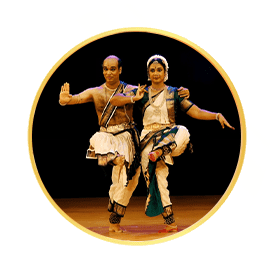Telugu is one of the most spoken languages in India. It is the official language of both Andhra Pradesh and Telangana, and it belongs to the Dravidian language family. With a script that is both distinct and structured, Telugu is used in education, governance, literature, and daily life. It is also one of the few Indian languages granted classical status, a recognition given to languages with a long literary tradition and historical depth. Telugu remains a language of expression, emotion, and tradition. Its use in music has followed a path through classical, folk, and cinematic forms. The evolution and development of Telugu music show how language, sound, and culture grow together. This journey has shaped not only how music is created but also how it is heard, remembered, and shared. The spoken form of Telugu follows a natural rhythm. Its sounds are clear, and its syllables carry a balance that lends themselves well to both speech and song. This has made it not only a medium for communication but also a carrier of artistic expression. Telugu literature spans religious works, poetry, drama, and storytelling. These texts reflect the cultural life of the Telugu-speaking people and show how language can hold memory, belief, and identity. For many, Telugu is more than just a means of communication. It is a connection to family, place, and community. It forms the base of how people think, learn, and express emotion. Its continued use across generations is supported not only by formal institutions but also by music, media, and conversation. Telugu music reflects the same structure and clarity found in the language. It began through devotional compositions that were sung in temples, homes, and gatherings. These early songs were often written by saint-poets who used melody to express devotion, ethics, and reflection. Their compositions are still studied and sung in the Carnatic classical music tradition. Alongside formal music, Telugu-speaking regions developed a wide range of folk songs. These songs were not written for performance halls but were sung during daily work, seasonal changes, and local festivals. They often used simple lyrics, repeated melodies, and regional instruments. Folk music preserved stories, passed along customs, and created space for shared experience. In the twentieth century, film music became the most accessible form of Telugu music. With the rise of the Telugu film industry, songs have become an integral part of cinema. Music directors composed songs that matched the emotions of scenes and the moods of characters. Playback singers gave voice to actors, and these voices became familiar across homes and communities. Film songs were broadcast through the radio and played at local events. People memorized lyrics, discussed melodies, and followed singers. These songs became part of everyday life. Many were used in weddings, celebrations, and public gatherings. Over time, Telugu music became a combination of classical roots, folk influence, and modern adaptation. This layered history is still present in the songs released today. Karaoke has introduced a new way for people to engage with music. Instead of listening alone, people now sing along using instrumental tracks. This makes the experience more active. It allows the listener to step into the role of the performer. Our Karaoke Tracks in Telugu provide the structure of the original song but leave space for individual voices. Using Telugu Karaoke Tracks, speakers find easy ways to sing at home, during family gatherings, school programs, or small cultural events. These tracks help users prepare for performances, practice pronunciation, or simply enjoy singing their favorite songs. Among the most requested songs in our collection are Oo Antava Oo Oo Antava and Naatu Naatu, which are often picked for their energy and crowd appeal. These tracks have become popular not just for personal enjoyment but also for group performances and online videos. Songs like Hoyna Karaoke, Inkem Inkem Inkem Kaavaale Karaoke, Butta Bomma Karaoke, Samajavaragamana Karaoke, and Srivalli Karaoke are also widely searched. Their strong melodies and familiar lyrics make them suitable for singers of different skill levels, and they continue to attract attention through repeated use in karaoke performances across different setups. Karaoke has also helped Telugu songs become more visible. When people record and share their karaoke performances, they bring attention to songs that may not be trending or recent. This has led to a wider appreciation of older film songs, devotional tracks, and even regional folk tunes. A song that was once limited to a scene in a film can now appear in a family video or a social media post. This continuous cycle of singing, sharing, and rediscovering gives Telugu songs a longer lifespan. Our Telugu Karaoke Tracks are produced to keep this experience smooth and reliable. Each track matches the original structure of the song. Timing is preserved. The instrumental quality is clean. Lyrics are available for those who want guidance during the song. For users who prefer an instrumental-only version, non-lyric tracks are also provided. Our collection includes songs from different periods of Telugu cinema, devotional songs, and regionally known folk-style tunes. Users can browse the catalog, search by song name, or explore by category. Each track is made for performance, practice, and learning. The goal is to make the act of singing accessible and satisfying. Telugu as a language continues to shape how people think and connect. Its structure supports clear thought and natural rhythm. Telugu music has taken this structure and built a wide range of forms over time. From classical compositions to folk songs and modern film tracks, it has created a record of cultural movement. We offer Telugu Songs Karaoke, which allows users to choose from a wide range of film tracks, devotional pieces, and folk-inspired tunes. These karaoke versions make it easier for anyone to sing along, practice vocals, or prepare for events. As more people explore Telugu Karaoke, the demand for accurate and well-arranged karaoke tracks continues to grow, helping songs reach new listeners and keeping classic melodies in active circulation. Karaoke now gives people a way to keep that movement alive. It brings old songs into present voices. It opens up music to anyone who wants to sing. It supports memory, learning, and sharing. As more people participate, the songs continue to travel, the language continues to be spoken, and the music continues to live. Explore and start singing with our Telugu Karaoke Tracks and bring familiar songs into your voice. Each track is arranged for clear performance, making it easy to sing at home, on stage, or in recordings. As you explore and perform, you help keep Telugu music present and active across generations. Browse the collection and begin your next song today.





















